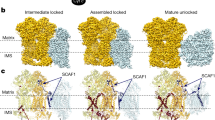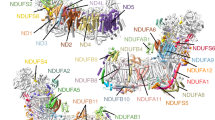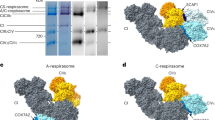Abstract
Respiratory chain complexes execute energy conversion by connecting electron transport with proton translocation over the inner mitochondrial membrane to fuel ATP synthesis. Notably, these complexes form multi-enzyme assemblies known as respiratory supercomplexes. Here we used single-particle cryo-EM to determine the structures of the yeast mitochondrial respiratory supercomplexes III2IV and III2IV2, at 3.2-Å and 3.5-Å resolutions, respectively. We revealed the overall architecture of the supercomplex, which deviates from the previously determined assemblies in mammals; obtained a near-atomic structure of the yeast complex IV; and identified the protein-protein and protein-lipid interactions implicated in supercomplex formation. Take together, our results demonstrate convergent evolution of supercomplexes in mitochondria that, while building similar assemblies, results in substantially different arrangements and structural solutions to support energy conversion.
This is a preview of subscription content, access via your institution
Access options
Access Nature and 54 other Nature Portfolio journals
Get Nature+, our best-value online-access subscription
$29.99 / 30 days
cancel any time
Subscribe to this journal
Receive 12 print issues and online access
$189.00 per year
only $15.75 per issue
Buy this article
- Purchase on Springer Link
- Instant access to full article PDF
Prices may be subject to local taxes which are calculated during checkout




Similar content being viewed by others
Data availability
The maps have been deposited at the Electron Microscopy Data Bank under accession codes EMD-0004 (S. cerevisiae respiratory supercomplex III2IV), EMD-0005 (S. cerevisiae supercomplex class 1, III2IV), and EMD-0006 (S. cerevisiae supercomplex class 2, III2IV2). Atomic coordinates have been deposited at the PDB with accession code 6GIQ.
References
Joseph-Horne, T., Hollomon, D. W. & Wood, P. M. Fungal respiration: a fusion of standard and alternative components. Biochim. Biophys. Acta 1504, 179–195 (2001).
Kawamata, H. & Manfredi, G. Proteinopathies and OXPHOS dysfunction in neurodegenerative diseases. J. Cell. Biol. 216, 3917–3929 (2017).
Kauppila, T. E., Kauppila, J. H. & Larsson, N. G. Mammalian mitochondria and aging: an update. Cell. Metab. 25, 57–71 (2017).
Couvillion, M. T., Soto, I. C., Shipkovenska, G. & Churchman, L. S. Synchronized mitochondrial and cytosolic translation programs. Nature 533, 499–503 (2016).
Ndi, M., Marin-Buera, L., Salvatori, R., Singh, A. P. & Ott, M. Biogenesis of the bc 1 complex of the mitochondrial respiratory chain. J. Mol. Biol. 430, 3892–3905 (2018).
Timon-Gomez, A. et al. Mitochondrial cytochrome c oxidase biogenesis: recent developments. Semin. Cell. Dev. Biol. 76, 163–178 (2018).
Schägger, H. & Pfeiffer, K. Supercomplexes in the respiratory chains of yeast and mammalian mitochondria. EMBO J. 19, 1777–1783 (2000).
Cruciat, C. M., Brunner, S., Baumann, F., Neupert, W. & Stuart, R. A. The cytochrome bc 1 and cytochrome c oxidase complexes associate to form a single supracomplex in yeast mitochondria. J. Biol. Chem. 275, 18093–18098 (2000).
Davies, K. M., Blum, T. B. & Kuhlbrandt, W. Conserved in situ arrangement of complex I and III2 in mitochondrial respiratory chain supercomplexes of mammals, yeast, and plants. Proc. Natl Acad. Sci. USA 115, 3024–3029 (2018).
Barrientos, A. & Ugalde, C. I function, therefore I am: overcoming skepticism about mitochondrial supercomplexes. Cell. Metab. 18, 147–149 (2013).
Milenkovic, D., Blaza, J. N., Larsson, N. G. & Hirst, J. The enigma of the respiratory chain supercomplex. Cell. Metab. 25, 765–776 (2017).
Letts, J. A. & Sazanov, L. A. Clarifying the supercomplex: the higher-order organization of the mitochondrial electron transport chain. Nat. Struct. Mol. Biol. 24, 800–808 (2017).
Lapuente-Brun, E. et al. Supercomplex assembly determines electron flux in the mitochondrial electron transport chain. Science 340, 1567–1570 (2013).
Bianchi, C., Genova, M. L., Parenti Castelli, G. & Lenaz, G. The mitochondrial respiratory chain is partially organized in a supercomplex assembly: kinetic evidence using flux control analysis. J. Biol. Chem. 279, 36562–36569 (2004).
Maranzana, E., Barbero, G., Falasca, A. I., Lenaz, G. & Genova, M. L. Mitochondrial respiratory supercomplex association limits production of reactive oxygen species from complex I. Antioxid. Redox. Signal. 19, 1469–1480 (2013).
Blaza, J. N., Serreli, R., Jones, A. J., Mohammed, K. & Hirst, J. Kinetic evidence against partitioning of the ubiquinone pool and the catalytic relevance of respiratory-chain supercomplexes. Proc. Natl Acad. Sci. USA 111, 15735–15740 (2014).
Gu, J. et al. The architecture of the mammalian respirasome. Nature 537, 639–643 (2016).
Letts, J. A., Fiedorczuk, K. & Sazanov, L. A. The architecture of respiratory supercomplexes. Nature 537, 644–648 (2016).
Sousa, J. S., Mills, D. J., Vonck, J. & Kuhlbrandt, W. Functional asymmetry and electron flow in the bovine respirasome. eLife 5, e21290 (2016).
Guo, R., Zong, S., Wu, M., Gu, J. & Yang, M. Architecture of human mitochondrial respiratory megacomplex I2III2IV2. Cell 170, 1247–1257.e12 (2017).
Sun, C. et al. Structure of the alternative complex III in a supercomplex with cytochrome oxidase. Nature 557, 123–126 (2018).
Heinemeyer, J., Braun, H. P., Boekema, E. J. & Kouril, R. A structural model of the cytochrome c reductase/oxidase supercomplex from yeast mitochondria. J. Biol. Chem. 282, 12240–12248 (2007).
Mileykovskaya, E. et al. Arrangement of the respiratory chain complexes in Saccharomyces cerevisiae supercomplex III2IV2 revealed by single particle cryo-electron microscopy. J. Biol. Chem. 287, 23095–23103 (2012).
Hunte, C., Koepke, J., Lange, C., Rossmanith, T. & Michel, H. Structure at 2.3 Å resolution of the cytochrome bc 1 complex from the yeast Saccharomyces cerevisiae co-crystallized with an antibody Fv fragment. Structure 8, 669–684 (2000).
Marechal, A., Meunier, B., Lee, D., Orengo, C. & Rich, P. R. Yeast cytochrome c oxidase: a model system to study mitochondrial forms of the haem-copper oxidase superfamily. Biochim. Biophys. Acta 1817, 620–628 (2012).
Solmaz, S. R. & Hunte, C. Structure of complex III with bound cytochrome c in reduced state and definition of a minimal core interface for electron transfer. J. Biol. Chem. 283, 17542–17549 (2008).
Brugna, M. et al. A spectroscopic method for observing the domain movement of the Rieske iron-sulfur protein. Proc. Natl Acad. Sci. USA 97, 2069–2074 (2000).
Wu, M., Gu, J., Guo, R., Huang, Y. & Yang, M. Structure of mammalian respiratory supercomplex I1III2IV1. Cell 167, 1598–1609.e10 (2016).
Brandt, U., Uribe, S., Schagger, H. & Trumpower, B. L. Isolation and characterization of QCR10, the nuclear gene encoding the 8.5-kDa subunit 10 of the Saccharomyces cerevisiae cytochrome bc 1 complex. J. Biol. Chem. 269, 12947–12953 (1994).
Lange, C., Nett, J. H., Trumpower, B. L. & Hunte, C. Specific roles of protein-phospholipid interactions in the yeast cytochrome bc 1 complex structure. EMBO J. 20, 6591–6600 (2001).
Brzezinski, P. & Adelroth, P. Pathways of proton transfer in cytochrome c oxidase. J. Bioenerg. Biomembr. 30, 99–107 (1998).
Tsukihara, T. et al. The low-spin heme of cytochrome c oxidase as the driving element of the proton-pumping process. Proc. Natl Acad. Sci. USA 100, 15304–15309 (2003).
Ostermeier, C., Harrenga, A., Ermler, U. & Michel, H. Structure at 2.7 A resolution of the Paracoccus denitrificans two-subunit cytochrome c oxidase complexed with an antibody FV fragment. Proc. Natl Acad. Sci. USA 94, 10547–10553 (1997).
Strecker, V. et al. Supercomplex-associated Cox26 protein binds to cytochrome c oxidase. Biochim. Biophys. Acta 1863, 1643–1652 (2016).
Levchenko, M. et al. Cox26 is a novel stoichiometric subunit of the yeast cytochrome c oxidase. Biochim. Biophys. Acta 1863, 1624–1632 (2016).
Chen, Y. C. et al. Identification of a protein mediating respiratory supercomplex stability. Cell. Metab. 15, 348–360 (2012).
Strogolova, V., Furness, A., Robb-McGrath, M., Garlich, J. & Stuart, R. A. Rcf1 and Rcf2, members of the hypoxia-induced gene 1 protein family, are critical components of the mitochondrial cytochrome bc 1-cytochrome c oxidase supercomplex. Mol. Cell. Biol. 32, 1363–1373 (2012).
Vukotic, M. et al. Rcf1 mediates cytochrome oxidase assembly and respirasome formation, revealing heterogeneity of the enzyme complex. Cell. Metab. 15, 336–347 (2012).
Zhou, S. et al. Solution NMR structure of yeast Rcf1, a protein involved in respiratory supercomplex formation. Proc. Natl Acad. Sci. USA 115, 3048–3053 (2018).
Garlich, J., Strecker, V., Wittig, I. & Stuart, R. A. Mutational analysis of the QRRQ motif in the yeast Hig1 type 2 protein Rcf1 reveals a regulatory role for the cytochrome c oxidase complex. J. Biol. Chem. 292, 5216–5226 (2017).
Burke, P. V., Raitt, D. C., Allen, L. A., Kellogg, E. A. & Poyton, R. O. Effects of oxygen concentration on the expression of cytochrome c and cytochrome c oxidase genes in yeast. J. Biol. Chem. 272, 14705–14712 (1997).
Zhang, M., Mileykovskaya, E. & Dowhan, W. Gluing the respiratory chain together. Cardiolipin is required for supercomplex formation in the inner mitochondrial membrane. J. Biol. Chem. 277, 43553–43556 (2002).
Shimada, S. et al. Complex structure of cytochrome c-cytochrome c oxidase reveals a novel protein-protein interaction mode. EMBO J. 36, 291–300 (2017).
Perez-Perez, R. et al. COX7A2L is a mitochondrial complex III binding protein that stabilizes the III2+IV supercomplex without affecting respirasome formation. Cell Rep. 16, 2387–2398 (2016).
Ikeda, K., Shiba, S., Horie-Inoue, K., Shimokata, K. & Inoue, S. A stabilizing factor for mitochondrial respiratory supercomplex assembly regulates energy metabolism in muscle. Nat. Commun. 4, 2147 (2013).
Mourier, A., Matic, S., Ruzzenente, B., Larsson, N. G. & Milenkovic, D. The respiratory chain supercomplex organization is independent of COX7a2l isoforms. Cell. Metab. 20, 1069–1075 (2014).
van der Laan, M. et al. A role for Tim21 in membrane-potential-dependent preprotein sorting in mitochondria. Curr. Biol. 16, 2271–2276 (2006).
Moreno-Lastres, D. et al. Mitochondrial complex I plays an essential role in human respirasome assembly. Cell. Metab. 15, 324–335 (2012).
Fedor, J. G. & Hirst, J. Mitochondrial supercomplexes do not enhance catalysis by quinone channeling. Cell. Metab. 28, 525–531.e4 (2018).
Melo, A. M. & Teixeira, M. Supramolecular organization of bacterial aerobic respiratory chains: from cells and back. Biochim. Biophys. Acta 1857, 190–197 (2016).
Graf, S. et al. Rapid electron transfer within the III-IV supercomplex in corynebacterium glutamicum. Sci. Rep. 6, 34098 (2016).
de la Rosa-Trevin, J. M. et al. Scipion: a software framework toward integration, reproducibility and validation in 3D electron microscopy. J. Struct. Biol. 195, 93–99 (2016).
Li, X. et al. Electron counting and beam-induced motion correction enable near-atomic-resolution single-particle cryo-EM. Nat. Methods 10, 584–590 (2013).
Rohou, A. & Grigorieff, N. CTFFIND4: fast and accurate defocus estimation from electron micrographs. J. Struct. Biol. 192, 216–221 (2015).
de la Rosa-Trevin, J. M. et al. Xmipp 3.0: an improved software suite for image processing in electron microscopy. J. Struct. Biol. 184, 321–328 (2013).
Kimanius, D., Forsberg, B. O., Scheres, S. H. & Lindahl, E. Accelerated cryo-EM structure determination with parallelisation using GPUs in RELION-2. eLife 5, e18722 (2016).
Punjani, A., Rubinstein, J. L., Fleet, D. J. & Brubaker, M. A. cryoSPARC: algorithms for rapid unsupervised cryo-EM structure determination. Nat. Methods 14, 290–296 (2017).
Rosenthal, P. B. & Henderson, R. Optimal determination of particle orientation, absolute hand, and contrast loss in single-particle electron cryomicroscopy. J. Mol. Biol. 333, 721–745 (2003).
Emsley, P., Lohkamp, B., Scott, W. G. & Cowtan, K. Features and development of Coot. Acta Crystallogr. D Biol. Crystallogr. 66, 486–501 (2010).
Pettersen, E. F. et al. UCSF Chimera—a visualization system for exploratory research and analysis. J. Comput. Chem. 25, 1605–1612 (2004).
Chen, V. B. et al. MolProbity: all-atom structure validation for macromolecular crystallography. Acta Crystallogr. D Biol. Crystallogr. 66, 12–21 (2010).
Barad, B. A. et al. EMRinger: side chain-directed model and map validation for 3D cryo-electron microscopy. Nat. Methods 12, 943–946 (2015).
Acknowledgements
We would like to thank Gunnar von Heijne, José Miguel de la Rosa-Trevin, and Stefan Fleischmann from the cryo-EM facility at SciLifelab, Solna, Sweden, for support. We would like to thank Pia Ädelroth, Stockholm University, and the members of our group for stimulating discussions. This work was supported by grants from the Knut and Alice Wallenberg Foundation, the Carl Tryggers Foundation, and the Swedish Research Council.
Author information
Authors and Affiliations
Contributions
L.M.B. purified supercomplexes. S.R., J.B., and J.C. collected and processed the data, and built and refined the model. M.C. and J.C. supervized data collection. S.R., J.B., P.B., and M.O. analysed and interpreted the structure. M.O. supervized and coordinated the project. S.R., J.B., J.C., and M.O. wrote the manuscript. All authors commented on the final version of the manuscript.
Corresponding author
Ethics declarations
Competing interests
The authors declare no competing interests.
Additional information
Publisher’s note: Springer Nature remains neutral with regard to jurisdictional claims in published maps and institutional affiliations.
Integrated supplementary information
Supplementary Figure 1 Protein purification and workflow of cryo-EM image processing.
a, BN PAGE of total mitochondria (T) and elution (E) after purification. b, A representative cryo-EM micrograph from dataset 3. The scale bar is set to 390 Å. c, Representative 2D classes show multiple orientations and classes. The box size is 370 pixels with a pixel size of 1.06 Å. d, Workflow of cryo-EM image processing.
Supplementary Figure 2 Global and local resolution of the refined density maps of class 1, class 2 and III2IV modeling map.
a, Gold-standard Fourier shell correlation curves of the density maps after the final homologous refinements. The resolution of class 1, class 2 and the III2IV modeling map are 3.34 Å, 3.50 Å and 3.23 Å, respectively. b, The FSC curves calculated for class 1 and the modeling map to the final refined model. c–e, Local resolution maps of class 1, class 2 and the III2IV modeling map viewed from two rotations along the membrane and from the matrix side.
Supplementary Figure 3 Superposition of subunits of the yeast supercomplex (III2IV) with the corresponding proteins from cow (Bos taurus) and pig (Sus scrofa).
a, Superposition of yeast Cor1 (PDB 3CX5) with Cor1 from the yeast supercomplex, III2IV, showing comparison between Cor1 subunit bound to Cox5a and the unoccupied side of CIII. b, Superposition of yeast Rip1 (PDB 3CX5) and the S. scrofa Rip1, in the loading state (PDB 5GUP) with Rip1 from the yeast supercomplex, (III2IV) show significant movement of the head domain and the hinge region residues: 90–93 compared to the yeast crystal structure but similar to the Rip1 in the loading state from the mammalian respirasomes. c, Superposition of the cytochrome c oxidase from the yeast supercomplex, III2IV, with bovine cytochrome c oxidase (PDB 1V54). d, Superposition of Cox4 (PDB 1V54) with Cox5a from the yeast supercomplex, III2IV.
Supplementary Figure 4 Structure of Qcr10 and identification of a novel subunit in the yeast supercomplex (III2IV).
a, Density and de novo model of the Qcr10 subunit of cytochrome bc1 complex demonstrating the quality of the map. b, Density and polyalanine model of an unidentified subunit in the cytochrome c oxidase in III2IV.
Supplementary Figure 5 Example densities of CIII subunits with phospholipids and CIV subunits of the yeast supercomplex (III2IV).
a, Example densities of phosholipids and the transmembrane helices from the modeling map of III2IV of the CIII region, demonstrating the quality of the map and the interaction of side chains with phospholipids. b, Example densities of the transmembrane helices from the modeling map of III2IV of the CIV region.
Supplementary Figure 6 Ubiquinones (UQ6) trapped in the catalytic Qi site of CIII.
a, Section of the CIII dimer from the supercomplex III2IV showing the rim of the quinone reduction (Qi site) cavity. The rim of the cavity is formed by four subunits of CIII, Qcr10, Qcr9, Rip1 and Cob. The UQ6 molecule in the catalytic site and the hemes (bH and bL) are highlighted in red and blue, respectively. b, Map density carved around the model of the two cytochrome b subunits of CIII, demonstrating the density of two ubiquinone molecules (UQ6), highlighted in blue. The UQ6 model is shown in yellow.
Supplementary Figure 7 Protein sequence alignment of Cox5a and Cox5b from S. cerevisiae.
The interface residues between the Cox5 isoforms and Cor1 are highlighted in orange, and residues involved in possible key interactions are colored red. The sequence identity is 64% and the sequence similarity is 74%. Alignment was carried out with EMBOSS Needle and processed in Jalview.
Supplementary Figure 8 Lipid bridges in the yeast supercomplex (III2IV).
a, Density of the modeling map showing the lipid densities bridging the gaps between the two complexes. b, Zoomed-in view showing the two lipid bridges and the subunits involved in the protein-lipid interactions in the yeast supercomplex.
Supplementary Figure 9 Protein sequence alignment of UQCRC1/Cor1 from different mammals and fungi.
Mammalian species aligned are Homo sapiens (human), Bos taurus (cow), and Mus musculus (mouse). Fungal species aligned are Yarrowia lipolytica, Candida albicans, Scheffersomyces stipitis, Spathaspora passalidarum, Saccharomyces cerevisiae (baker’s yeast), Kluyveromyces marxianus, and Zygosaccharomyces rouxii. Yeast indicated with an asterisk corresponds to species with CI and yeast indicated with double asterisks contains no CI. The interface loop of UQCRC1/Cor1 is highlighted in orange. Alignment was carried out with Clustal Omega and processed in Jalview.
Supplementary information
Supplementary Text and Figures
Supplementary Figures 1–9 and Supplementary Table 1
Rights and permissions
About this article
Cite this article
Rathore, S., Berndtsson, J., Marin-Buera, L. et al. Cryo-EM structure of the yeast respiratory supercomplex. Nat Struct Mol Biol 26, 50–57 (2019). https://doi.org/10.1038/s41594-018-0169-7
Received:
Accepted:
Published:
Issue Date:
DOI: https://doi.org/10.1038/s41594-018-0169-7
This article is cited by
-
Cryo-EM structure and function of S. pombe complex IV with bound respiratory supercomplex factor
Communications Chemistry (2023)
-
Structural insights into cardiolipin replacement by phosphatidylglycerol in a cardiolipin-lacking yeast respiratory supercomplex
Nature Communications (2023)
-
The assembly, regulation and function of the mitochondrial respiratory chain
Nature Reviews Molecular Cell Biology (2022)
-
NMR structural analysis of the yeast cytochrome c oxidase subunit Cox13 and its interaction with ATP
BMC Biology (2021)
-
Structure and assembly of the mammalian mitochondrial supercomplex CIII2CIV
Nature (2021)



